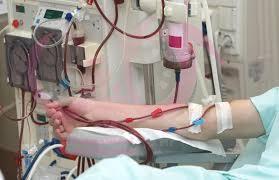Detailed report on renal dialysis

Detailed report on renal dialysis – The kidneys work to purify the blood from toxins and remove it from salts, which is a line of defense and protection of the body from the impact of those wastes on the body
How long can you live without dialysis
Dialysis life expectancy by age
and when the kidneys to some diseases that lead to failure and inability to perform its normal function requires human intervention and external dialysis,
which coincides with regularity on Medications, treatments and a special diet pattern
Detailed report on renal dialysis
Renal dialysis is done at specialist centers under the supervision of a specialist kidney and kidney medical staff.
Kidney dialysis is divided into two different types: dialysis and dialysis
Patients need renal dialysis when the kidneys fail to get rid of the waste and fluids from the blood through the urine,
when the kidneys work efficiently only 10-15%,
and symptoms are in the form of nausea, swelling, vomiting, fatigue and fatigue, itching skin, legs restlessness, Osteoporosis,
the most common symptom among renal dialysis patients,
while some people may not have symptoms and only the doctor can detect them and determine the need for dialysis
Diabetes Complications – Maintain Kidneys Balanced
Interesting Info about Kidney Dialysis
Hemodialysis
The kidneys (renal dialysis machine) purify the blood by passing through special filters by opening the blood vessels through a simple operation in the arm. The filter consists of two parts:
The first is for the passage of the fetus,
and the second is for the dialysis to separate the thin membrane. Urea, creatinine, potassium through the membrane to be discarded out,
and remain blood cells and proteins as they are because their size is not allowed to pass through the membrane
Each dialysis session takes approximately 4 hours and is repeated three times a week.
Regularity of the dialysis sessions improves the patient’s overall health,
enabling him to live longer, taking regular tests every month, and taking the medication prescribed by the doctor.
Follow-up in renal dialysis centers
Some patients need dialysis for a limited period until their health improves,
but in other cases when chronic kidney disease progresses and leads to kidney failure,
the kidneys do not improve, which means the patient will continue to dial for renal dialysis or take a kidney transplant
Kidney dialysis needs to stabilize some needles, which makes it annoying to the patient at the beginning of the washing sessions,
but the patient gets used to the situation over time as the doctors try to place the needles in a comfortable way for the patient during the session,
and the patient during the session for some side effects such as colic, headache, dizziness,
Is not common, with some steps that doctors can dialysis centers to follow to reduce such symptoms as:
Slowly remove liquids, which can increase the time of dialysis session
Increase the amount of sodium in the fluid diala
Follow up high blood pressure medicines
Set dry weight or target weight
Cooling of the wheel
Use of medicines to prevent hypotension during the dialysis session
Follow the patient to a special diet to reduce the side effects of dialysis, as he loses a lot of fluids during which, which leads to fatigue and fatigue
Diabetes and Excessive Blood Force May result in Kidney Failing
Kidney Disease Ideas and Diet
Diet
Having a patient with renal failure is a special diet that is one of the elements of treatment and health improvement.
The nutritionist determines the meals and determines the amount of fluids that the patient should drink regularly.
Although the kidney patient needs liquids, the increase in the amount of them works on high blood pressure and heart stress.
Foods rich in phosphorus, such as milk, cheese, white beans, and nuts, can cause phosphorus, skin and bone weakness, reduce sodium intake,
and reduce high proteins, thereby reducing urea-derived waste in the blood